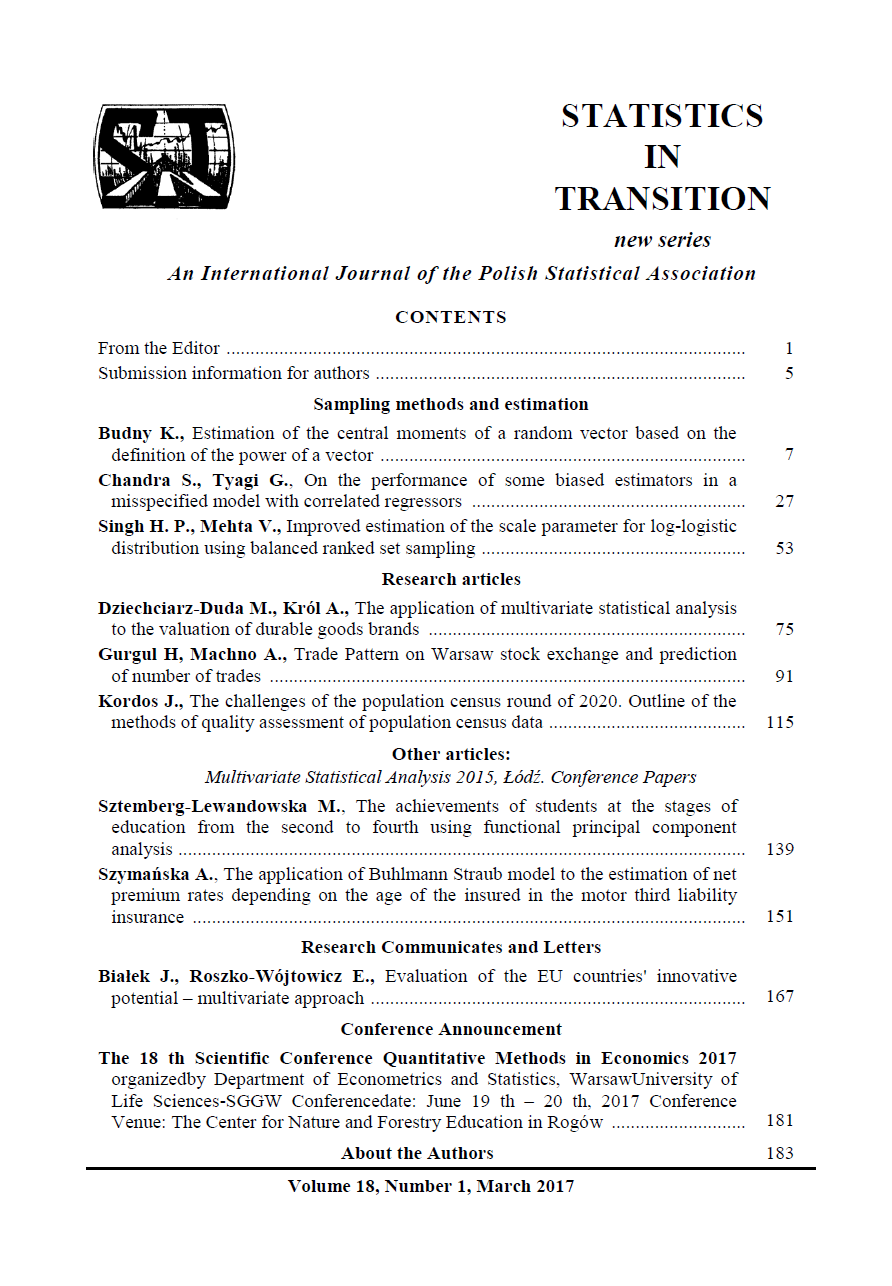ARTICLE
ABSTRACT
The aim of the article is to work out a synthetic measure for estimating country’s innovation potential (CIP) of EU economies. For the purpose of the research, data from the European Statistical Office (Eurostat) are used and several indicators are organized by four different areas of analysis, i.e. investment expenditure, education, labour market and effects. Applying multi-dimensional statistics allows us to reduce the primary set of diagnostics variables and, simultaneously, identify those which best describe the potential. The final step is linear ordering of EU countries according to their innovative potential on the basis of CIP synthetic measure. The rating is compared with other ratings based on the recognized Summary Innovation Index and Global Innovation Index. The main conclusion is that the methodology of innovativeness assessment remains an open issue and requires further research. The most important task is the selection of indicators, followed by statistical verification in relation to their importance to innovativeness. The results show that there is a tendency to between the author’s ratings and other already published ratings of innovativeness.
KEYWORDS
innovativeness, Innovation Union Scoreboard, European Union, cluster analysis, factor analysis
REFERENCES
BĄK A., (2015). Zagadnienie wyboru optymalnej procedury porządkowania liniowego w pakiecie pllord, [w:] Prace naukowe Uniwersytetu Ekonomicznego we Wrocławiu, No. 384, pp. 33–41, Wrocław.
CATTELL R. B., (1966). The scree test for the number of factors, Multivariate Behavioral Research, 1, pp. 245–276.
CHERCHYE, L., LOVELL, C.A.K., MOESEN, W., VAN PUYENBROECK, T., (2005). One market, one number? A composite indicator assessment of EU internal market dynamics, Discussion Paper Series DPS 05.13. Center for Economic Studies, Leuven University,http://www.uni-trier.de/fileadmin/fb4/projekte/SurveyStatisticsNet/KEI WP5-D5.2.pdf.
CHILD, D., (2006). The Essentials of Factor Analysis (3rd ed.), Continuum International.
CORNELIUS, P., MCARTHUR, J. W., (2002). The Global Competitiveness Report 2001-2002, World Economic Forum, Oxford University Press, New York, Oxford, http://www.nectec.or.th/pld/indicators/documents/WEF-%20Global%20Competitiveness%20Report%202001.pdf.
DRUCKER, P. F., (2004). Natchnienie i fart, czyli innowacja i przedsiębiorczość, Studio Emka, Warszawa 2004.
DUTTA, S., LANVIN, B., WUNSCH-VINCENT, S. (ed.), (2015). The Global Innovation Index 2015. Effective Innovation Policies for Development, Cornell University, INSEAD, the World Intellectual Property Organization (WIPO), Fontainebleau, Ithaca, and Geneva, https://www.globalinnovationindex.org/userfiles/file/reportpdf/gii-full-report 2015-v6.pdf.
EUROPEAN COMMISSION, (2013). Innovation Union. A pocket guide on a Europe 2020 Initiative, Publications Office of the European Union Luxembourg, Belgium.
EUROPEAN COMMISSION, (2013). Powering European Public Sector Innovation: Towards a New Architecture, Report of the Expert Group on Public Sector Innovation, Directorate General for Research and Innovation, Publications Office of the European Union, Luxembourg, https://ec.europa.eu/research/innovation-union/pdf/psi_eg.pdf.
EUROPEAN COMMISSION, (2013). Measuring innovation output in Europe: towards a new indicator, Communication from the Commission to the European Parliament, the Council, the European Economic and Social Committee and the Committee of the Regions, Brussels.
EUROPEAN COMMISSION, (2015). Innovation Union Scoreboard 2015, Internal Market Industry, Entrepreneurship and SMEs, Belgium.
EVERITT, B., (2011). Cluster analysis, Chichester, West Sussex, U.K: Wiley.
FREUDENBERG, M., (2003). Composite indicators of country performance: a critical assessment, STI Working Paper 2003/16, http://www.oecd ilibrary.org/docserver/download/405566708255.pdf?expires=1483002854&id=id&accname=guest&checksum=C8780649DE56D4475FDEE57AF84A4F45.
GRANSTRAND, O., (1999). The Economics and Management of Intellectual Property. Towards Intellectual Capitalism, Edward Elgar, Cheltenham 1999
KAISER H. F., (1960). The application of electronic computers to factor analysis, Educational and Psychological Measurement, 20, pp. 141–151.
KLINGBEIL, M., (2008). Measuring Human Capital in the Knowledge Economy, Ministry of Advanced Education, Canada.
LUCAS, R. E., (1988). On the Mechanics of Economic Development, Journal of Monetary Economics, 1988, No. 21.
OECD, (2001). The New Economy: Beyond the Hype. The OECD Growth Project.
OECD, (2005). Good Practice Paper on ICTs for Economic Growth and Poverty Reduction, Paris, http://www.oecd.org/dac/35284979.pdf.
PILAT, D., WOELFL, A., (2003). ICT and Economic Growth – New Evidence From International Comparisons, OECD, Paris, http://www.tiger.edu.pl/konferencje/kwiecien2003/papers/Pilat_Woelfl.en.pdf.
PORTER, M. E., (2001). Porter o konkurencyjności, PWE, Warszawa.
ROGERS, E. M., (2003). Diffusion of Innovations, Free Press, New York.
SAISANA, M., TARANTOLA S., (2002). State-of-the-art Report on Current Methodologies and Practices for Composite Indicator Development, European Commission: Institute for the Protection and the Security of the Citizen Technological and Economic Risk Management Unit, Italy.
SOETE, L., (2000). Governing the Information Society, Communications & Strategies, Vol. 37, pp. 155–167.
THOMPSON, B., (2004). Exploratory and confirmatory factor analysis: Understanding concepts and applications, Washington DC: American Psychological Association.
WALESIAK, M., (1996). Metody analizy danych marketingowych, PWN, Warszawa 1996.
WHEATLEY, M., (2001). Innovation means relying on everyone’s creativity. Leader to Leader, (Spring),http://www.margaretwheatley.com/articles/innovationmeans.html.
